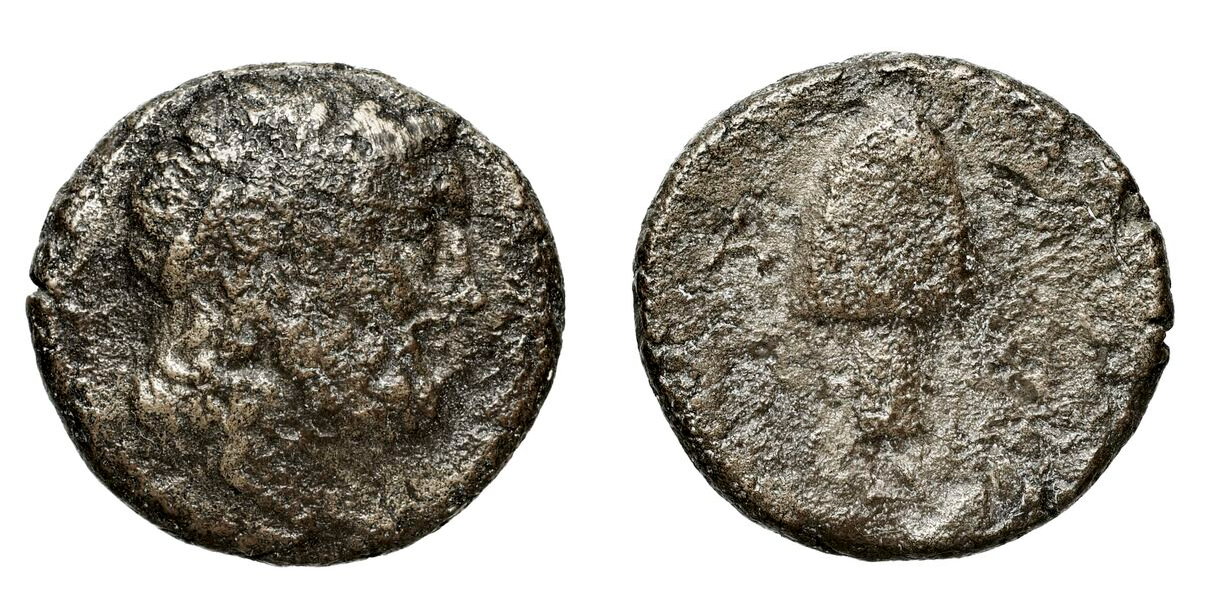S 516 - Aegiale, bronze, module A-B (220-180 BCE)
From SILVER
220 BCE - 180 BCE Bronze
Description
| ObverseInscription or printing placed on the obverse.: | Laureat and bearded head of Asklepios, right. |
| ReverseInscription or printing placed on the reverse.: | AI ou AIΓI (Greek).Cupping-vessel with a suspension ring. |
Mint and issuing power
| MintIdentifies the place of manufacture or issue of a numismatic object.: | Aegiale | Ancient regionAncient region.: | Cyclades | Modern countryModern country: Greece | AuthorityIdentifies the issuing power. The authority can be "pretended" when the name or the portrait of X is on the coin but he/she was not the issuing power. It can also be "uncertain" when there is no mention of X on the coin but he/she was the issuing power according to the historical sources: |
Chronology
| FromIdentifies the initial date in a range assigned in a numismatic context. | 220 BCE | toIdentifies the final date in a range assigned in a numismatic context.. | 180 BCE | PeriodTime period of the numismatic object.: Hellenistic 323-30 BC |
Physical description
| MetalThe physical material (usually metal) from which an object is made.: | Bronze |
Median weightMedian of the weights of numismatic objects (in grams). in grams | 4.50 | DenominationTerm indicating the value of a numismatic object. Examples: tetradrachm, chalkous, denarius.: | Module A-B | StandardStandard.: |
Image

S_516_-_Aegiale,_bronze,_module_A-B_(220-180_BCE).png [1]
References
| Die study referencePublication of the study: | Liampi 20041Liampi 2004, p. 97-100, n° 4-8 and 12-21 | ||
| Coin series referenceReference to coin series study: | |||
Obverse dies distribution
| FrequencyFrequency of specimen in distribution. ᵖ | Number of obversesNumber of obverse dies. ᵖ (o) | % (o) | Number of coinsNumber of coins. (n) | % (n) | Die nameName(s) of the die(s). |
| 1 | 1 | 12.5 | 1 | 1.19 | |
| 2 | 1 | 12.5 | 2 | 2.38 | |
| 4 | 1 | 12.5 | 4 | 4.76 | |
| 8 | 1 | 12.5 | 8 | 9.52 | |
| 13 | 1 | 12.5 | 13 | 15.48 | |
| 14 | 1 | 12.5 | 14 | 16.67 | |
| 21 | 2 | 25 | 42 | 50 | |
| Total | 8 of 8 | 100 | 84 of 84 | 100 |
Reverse dies distribution
no distribution is available
Quantification
| Number of obversesNumber of obverse dies. ᵖ (o) | 8 | Number of singletons (o1)The number of singleton coins. ᵖ | 1 |
| Number of reverse diesNumber of reverse dies. (r) | 13 | Number of coinsNumber of coins. (n) | 84 |
| Coins per obverse dieNumber of coins per obverse die. (n/o) | 10.5 | Coins per reverse dieNumber of coins per reverse die. (n/r) | 6.46 |
| Reverse per obverse ratioRatio of obverse dies divided by reverse dies. (r/o) | 1.63 | Percentage of singletons (o1)number of coins (n) divided by the number of singletons (o1) ᵖ | 12.5 % |
| Original number of dies (O) (Carter 1983 formula)The estimation of the number of coins according to Carter 1983 ᵖ | 8.09 | Coins struck if 20,000 as average productivity per dieCoins made if the average productivity for obverses (according to Carter) is 20,000. ᵖ | 161,800 |
| Original number of dies (O) (Esty 2011 formula)The estimation of the number of coins according to the singleton formula in Esty 2011 ᵖ (O) | 8.84 | Survival rate if 20,000 as average productivity per dieSurvival rate if average productivity is 20,000. ᵖ | 0.00052 |
| Coverage (o = % of O) (Esty 1984 formula)Esty 1984 - coverage (% of O) ᵖ (o = % of O) | 98.81% | Die productivity if survival rate 1/2,000Average productivity if survival rate is 1/2,000. ᵖ | 20,766.38 |
| Weight of silver (in kg) if 20,000 coins per die (O = Carter formula)Carter 1983 * Median weight * 20000 (*10 if gold or electrum) ᵖ | n.a. | Die productivity if survival rate 1/5,000Average productivity if survival rate is 1/5,000. ᵖ | 51,915.95 |
Remarks
References
- ^ Liampi, Katerini (2004), "The coinage of Amorgos: Aigiale, Arkesine, Minoa and the koinon of the Amorgians", Revue Numismatique, 160, p. 63-109, pl. 5-9.